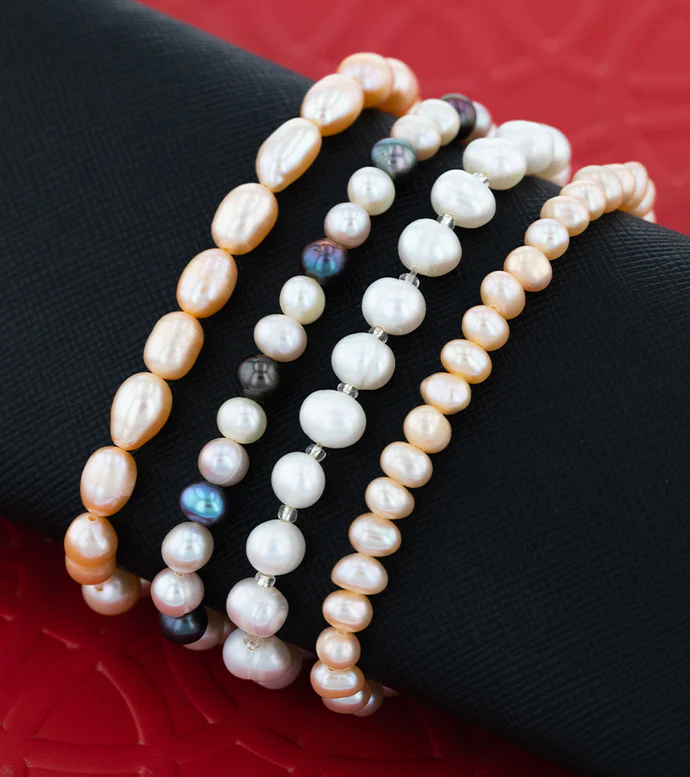Pearl Buyers Guide
Pearls are one the most highly valued organic gems in the world. They are a symbol of purity and modesty and that's what makes them so popular.
They can either be natural or cultured. Pearls are grown on farms, where oysters are cared for until they develop their own beautiful pearl. Most people are aware of the cream-white pearls that were made popular by Audrey Hepburn in 1961, but pearls naturally come in a tremendous variety of colours.
Shiels jewellery features different types of pearls, from ivory freshwater pearls, to brightly-coloured peacock green pearls. Our classic pearl necklaces are an all-time favourite, but we also have plenty more jewellery pieces that feature your favourite type of pearl.
To help you choose the best pearl jewellery for you, we've created a guide to help you along the way.
Overview:
- Buyers Guide
- Types of Pearls
- How to Buy Pearl Jewellery
- Pearl Lustre
- Pearl Size
- Pearl Similarity

Buyer's Guide
TYPES OF PEARLS
Pearls differ in colour, size and shape based on the variety of the mollusc, growing conditions, harvesting techniques and other factors.
South Sea pearls, cultured predominantly in Australian waters, are among the world's most sought-after and valuable pearls. The largest and most successful pearl farms are found off the coasts of Northern Territory and Western Australia. Efforts to replicate their quality elsewhere have seen limited success, making Australian pearls highly prized. Produced by carefully placing a mother-of-pearl bead inside an oyster, allowing it to develop layers of natural nacre over three years, South Sea pearls vary in lustre, shape, and color, influencing their market value. Ranging from creamy white to golden yellow and silver hues, each South Sea pearl is unique and precious in its own right.
Freshwater pearls, unlike their South Sea counterparts, are cultivated in freshwater mussels rather than ocean oysters. Due to the mussel's ability to produce pearls quickly, they are more cost-effective to produce, albeit lacking the luster of South Sea pearls. One mussel can yield multiple pearls simultaneously, contributing to their affordability. With freshwater pearl cultivation sites found worldwide, they are generally less expensive. The rise of high-quality round freshwater pearls is relatively recent, about 20 years, making pearls more accessible to a broader audience. While natural pearls have existed for millennia, the popularity of cultured pearls has surged with technological advancements. A woman's jewelry collection feels incomplete without the timeless elegance of pearls.
Tahitian pearls, cultured and harvested much like South Sea pearls, boast a rich spectrum of colors from deep black to silver grey. Despite their smaller size compared to South Sea pearls, black Tahitian pearls are highly coveted and can fetch premium prices in the market.
FACT: Tahitian oysters cannot grow white south sea style pearls. South sea pearl oysters cannot grow Tahitian style black pearls

How to buy pearl jewellery
When buying your pearl jewellery, there are a few things you should keep in mind:
PEARL LUSTRE
Lustre is the sharpness and intensity of reflections on the pearl's surface. This is the most important feature of a pearl.
When you buy pearl jewellery, look at the reflection of images on the pearl's surface. The closer to a mirror image you see, the better the lustre. Pearls with fine lustre also seem to glow warmly from within.
PEARL SIZE
Similar to diamonds, the size of the pearls used in any piece of jewellery is important for both aesthetic and financial reasons. The larger the pearl, the greater the cost, so remember to balance the size of the pearl with the expected cost.
PEARL SIMILARITY
When searching for pearl jewellery, look at how well matched the pearls are when combined in one piece of jewellery. With many subtleties in colour, shape and finish, even a slight difference can create an unbalanced look.
Ensure that you look for pearls that are similar in shape, size and colour but keep in mind that those more closely matched will be more expensive but reflect a higher quality of craftsmanship.




















